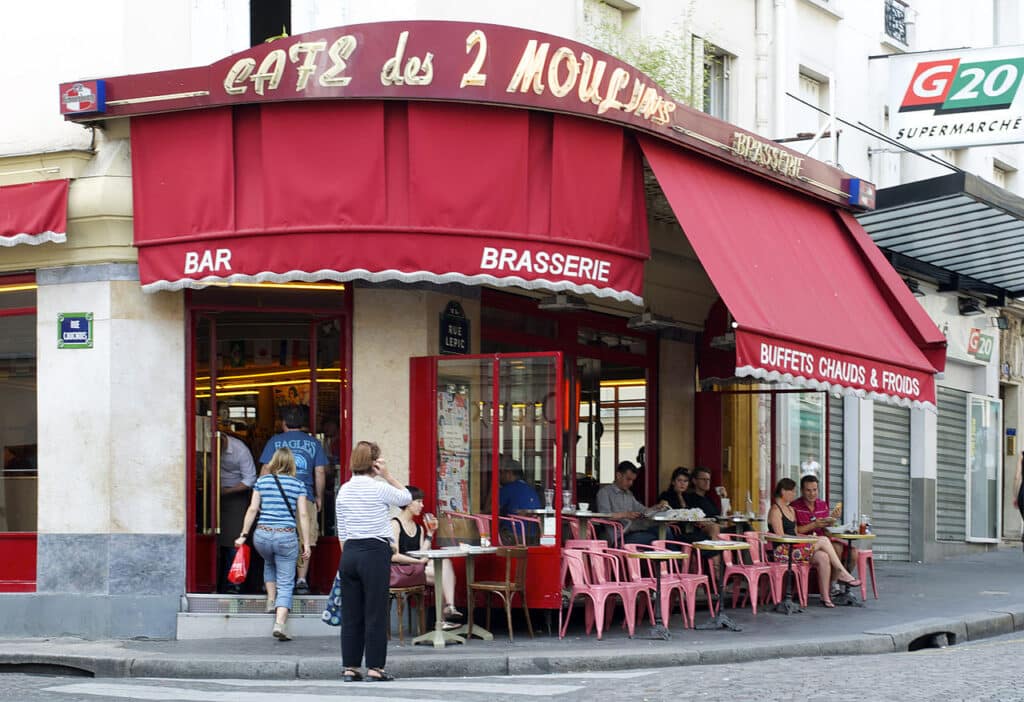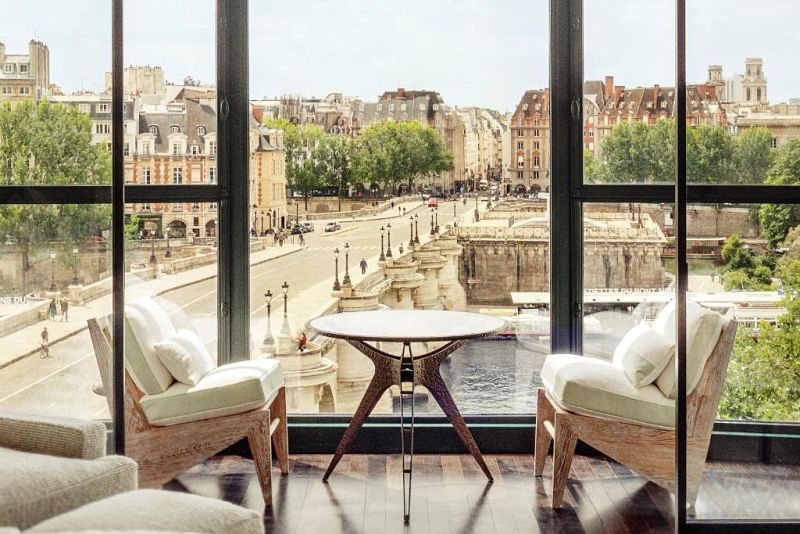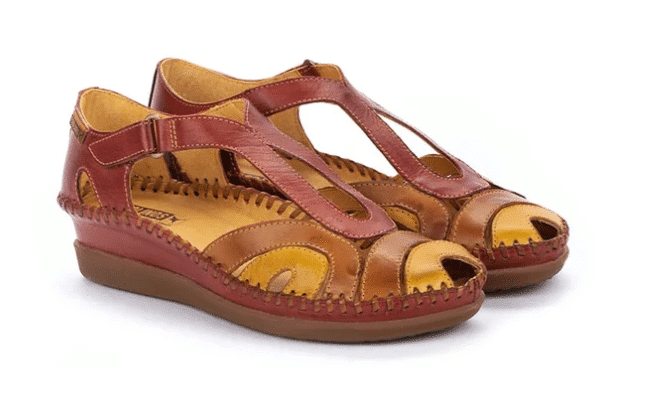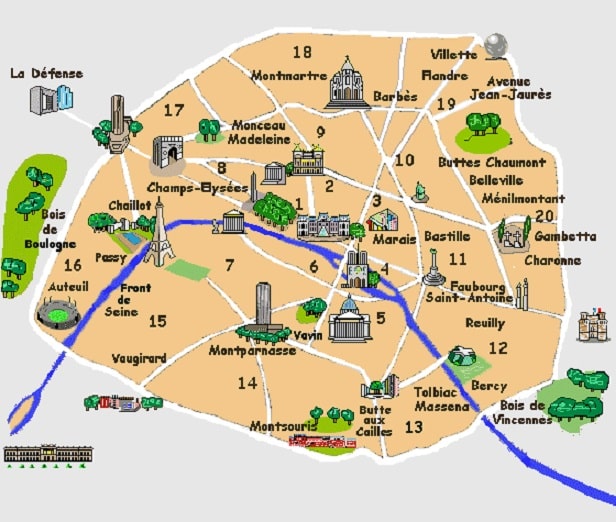What to know before visiting Paris ? Tips and tricks
This post is also available in:
![]()
What to know before visiting Paris ? When you live in Paris for a while, you learn to live like a Parisian. That is, to do certain things and not others. But these “rules” almost necessarily apply to visitors who are immersed for a few days in the Parisian whirlwind.
The following is a kind of crash course to prepare you for a pleasant and stress-free stay. For your convenience, everything is classified according to 7 topics. And the next time you visit Paris, keep all these things in mind, they will always be useful.
What to know before visiting Paris on the Parisian metro – and transportation in general

A few tips for getting around Paris
- Avoid to rent a car in Paris! The traffic is quite congested in some areas and the driving may be completely different from what you’re used to back home. Instead, public transportation can be found in abundance across the city
- Get a good offline map on your smartphone for the city and public transports.
In any case in all stations, on the internet and even at the station’s ticket office , all maps of metro, RER are available. Click on RATP maps (in English or french)
- Don’t buy tickets from random people, it’s a scam.
Tickets are bought in legit booths and vending machines inside the station. Since October 17, 2022 the metro ticket can be “loaded” directly into your smartphone.
- When passing the gates, pass the luggage FIRST (BEFORE you) or the door will close on it.
- If you have to stop to look for where you need to go, step aside
So you will not disturb the other passengers. The rule is to stand on the right side for “slower traffic line”. When you’re on escalators let people to pass you on your left. Parisians who often spend one or two hours each morning and evening to get home tend to be a bit impatient and many want to walk fast. They may not be very friendly in these circumstances.
- Keep your phone and wallet in your inner pockets and your bag safe and closed on your belly.
Pick pockets are here, mostly when the metro is crowded at peak hours and they don’t aim at locals, they’re here for you!
- Paris has one of the most dense metro network
It which means most of the time, it’s faster and more enjoyable to walk (Voir notre Post …) from one place to another than using public transport. Distances between stations are only a few hundred meters. Because of that, don’t rush on a daily pass: they’re expensive. Instead you can:- Buy tickets by the unit or even more economically by 10 at a time. Note also that the ticket you enter the metro is valid until you leave it, it could be the next station or at the other end of Paris. If you wish, you can stay in the metro the whole day for the price à one ticket ! Reminder: metro tickets can be “loaded” directly into your smartphone (see RATP maps).
- It’s often much easier (and faster) to travel by public transit in Paris than by car or taxi. It is operated by a single agency named RATP. It’s an exceptionally designed and maintained transit system for its size and age (1900). A weekly pass will run you about fifty euros and having Google Maps on your phone will help you navigate it with ease until you learn the lines, stations, and connections.
- If you get a transit pass, also spend one Euro or two to get your picture taken and printed, and stick it on the pass right then and there. Not having your picture glued to that damned thing is a fifty euro fine if an inspector sees your pass without it.
- You want to see the tour Eiffel for the first time and have a great memory of your first encounter with the Old Lady?
Don’t get out of the metro station “Bir-Hakeim – Tour Eiffel”. Instead, stop at Trocadero station (line 6 and 9). You will have a stunning view of the tower and the city, a nice walk to the Eiffel Tower through the Trocadero park (Lien) and across the Seine river.
- BUSES! they go quite fast when it is not the peak hours (too fast, hang on!), and you get to see the city.
- Check for the last metro at night.
It’s around midnight / 1:00 am, depending on the line and where your station is located on the line. After that, taxis are impossible to catch and more expensive as well as Uber and night buses may be crowded with drunk people. The first metro of the day is at about 5:00 am.
- Not an advice but a fact.
If you arrive from Roissy Charles De Gaulle airport, you will probably take the rapid train RER B. The train will go through the saddest, poorest suburbs and your first stop will be Gare du Nord, which is sad and dirty as well. So, don’t stop there for too long if you do not need to.
What to know before visiting Paris when you are in the streets

- Beware of pickpockets and common travel scams
- Don’t gamble or buy anything on the streets
Gambling can be seen on certain tourist streets, especially the little cups game. This is a scam to steal money from you. I know it seems like fun and harmless enough but there are actually a few people working together to make you believe it is safe. Avoid playing these games; you will just lose your money!
- Don’t butt out on the street
If you are a smoker, don’t throw your cigarette on the streets. A new law passed recently to prevent people from throwing their cigarette butts on the streets. Throw them in the trash. Otherwise, if a cop sees you, you will have to pay a fine of 68€. That’s a very expensive cigarette!
- Avoid restaurants in very touristy spots
Restaurants in really touristy places aren’t usually the best. Trust travel guides to lead you to great restaurants that are off the beaten track. Restaurants around the Eiffel Tower, the Arc de Triomphe or Notre-Dame may seem like typical French restaurants but they are not. You’ll spend a lot of money for a mediocre meal.
- Don’t buy croissants or bread in big chain stores
You know French people and their bread! They prefer buying bread like baguettes and croissants in local patisseries and boulangeries instead of big chain stores or supermarkets. In front of the widow is written “artisan boulanger”’ which imply that the goods are made fresh inside, not frozen!
- Avoid fancy cafés
Avoid fancy cafés where you pay way too much for your cup of coffee. Instead, search out little cafés in less touristy neighborhoods. You’ll pay way less and the coffee might even be better! And in lots of cafés, if you sit by the counter, cafés are even cheaper !
- Learn a few words in French
Parisians are not rude. At least not all of them. They just appreciate when you make an effort to say a few words in French. Just like Americans in the United States, they expect all the tourists speak English. A simple “bonjour” or “merci” shows that you’re trying. And French really appreciate it! There are also internet courses to learn the basics of French quickly, but you have to take them at least 2 or 3 months in advance. One of these free possibilities is Duolinguo “The free, fun and effective way to learn a language!”
- Walk, walk, walk
Opt for walking instead of taking the subway when you can. You might be surprised by the little streets, cute shops and amazing architecture you’d miss if you were simply taking the metro.
- Avoid expensive rooftops for a panoramic 360 view
If you’re looking for a killer view of Paris, you can avoid expensive rooftops, like on top of monuments. Instead, try to find hidden gems, like the Printemps Terrace where you have a 360 view for free or the George Pompidou Museum Terrace.
Look for less expensive but better views such as at the top of the Arc de Triomphe. Avoid climbing up the Eiffel Tower. It takes a lot of time (waiting). It’s very touristy and somewhat disappointing as we all want to see the Eiffel Tower in a skyline view of Paris!
- Know what to expect in August
If you visit Paris in August, know that a lot of Parisians are gone on vacation. So the city has a great vibe because you feel like you have it for to yourself. But be aware that lots of shops and restaurants are closed then. But that’s not necessarily a bad thing. It pushes you to walk off the beaten track to find a restaurant that is open and actually good.
Cafés and restaurants: what to know before visiting Paris ?

- A golden rule: a restaurant with a guy standing outside and trying to lure people in is not a top range restaurant. May be sufficient for a light lunch. And you’re not in a good area to have dinner.
- You can find authentic French food at reasonable prices
As an exemple, if you’re on the lookout for a reasonable price, head to “Bouillon Chartier” in the 9th arrondissement of the city. Though a little more touristy than some of the other destinations, service is fast and the restaurant is set against the backdrop of a Belle Époque dining room.
For a slightly more intimate and less touristy foodie experience in Paris, there is “Le Bistrot d’Henri” in the 6th arrondissement of the city.
You will also find on this site our “Relaxation Breaks” adresses (Pauses détente”) with lists of recommended various shops (Cafés, restaurants, patisseries, etc. ) and rated by the Tourits who came before you. They are “classified” by walks or neighborhoods. You’ll easily recognize them from the lists of posts on this site that begin with “Relaxation Breaks …”. For example: “Relaxation breaks on the Butte-Montmartre top of Paris walk”
- Bottled water (or mineral water) at a restaurant is quite expensive.
Instead ask for a tap water bottle (une “carafe” d’eau). It is free and the water is germ safe as it comes from the Paris potable network.
- Parisians (and the French in general) tend to eat late. Lunches are served between 11:30 am to 3:00 pm. Dining are usually not served before 7:15 pm and after 10:00pm.
- On night dining out : it is an eating experience
Make restaurant reservations in advance to be sure to have seats
If you meet up with Parisians to dine, expect an evening of food discoveries. Order “entrées” before the mains, followed by cheeses and/or deserts. A nice wine and settle in for a few hours of conversation. Voir notre Post
If you go in the spring or summer, try a “pastis” before your appetizer. It’s an acquired taste for some, but a fantastic aperitif for others.
Try some French cuisine and local specialties.
For more detailed information see Table etiquette : how to behave at a French table
- This should go without saying anywhere (not just Paris), but be friendly and kind to the staff serving your food and drink. The quality of service is more related to your manners and attitude than your money. On the subject of tipping, waiters in France get 15% of the bill as a service fee. Of course a tip of a few Euros is welcome if the service is particularly exceptionnel but not mandatory.
- Make the most of coffee culture
Sitting in a café, sipping on an espresso, and watching the world go by: it is perhaps one of Paris’ clichés. But, truth be told, you have to make the time to enjoy café culture at least once when in Paris.
In the past few years, coffee culture in Paris has exploded, resulting in exciting new openings and plenty of delicious caffeine stops across the city.
- Note that it can be cheaper to drink your coffee at the bar/ counter
- You can smoke on terraces in Paris
A few tips about lodging – What to know before visiting Paris

- Only book your accommodation close to the airport if you’re getting a flight early the next morning, and only then for that night only.
- Plan your accommodation well in advance and stay in a central location if possible
- Most of the luxury hotels can be found in the 8th arrondissement of the city, while more budget locations can be found near the “périphérique motorway”.
- When it comes to your Paris visit, accommodation is going to be a large portion (if not the largest allocation) of your travel budget. As such, I highly recommend booking your stay well in advance. Discounts are often higher. (Lien Booking)
- Write down your hotel and its address. Just for safety, if your phone fails as so often technology does. After Haussmannian renovations of the city in the 19th century, many streets across the French capital look pretty similar and it’s easy to get a little lost!
Other tips for yourself in the Parisian lifestyle

- Bring a comfortable pair of shoes
Paris is a city best explored on foot For example, our Le Marais elf guided walking tour will show you the best of medieval Paris and this old Paris vintage tour (Stroll in the Ile-de-la-Cité of Paris, 800 year history) will allow you to experience the highlights of the city in just a few hours. Don’t forget that shoe size numbers are different in Europe than in many other countries around the world. Try them on and take a few steps before you buy!
- Dress as the Parisians do
What this means is maintaining a largely neutral wardrobe. Skip the bold prints and bright sneakers. Instead, opt for a monochromatic feel (though neutral sneakers/ trainers are fine for walking around and is what many Parisians wear).
You don’t have to dress incredibly chic wherever you go. If dressing in heels and dresses is not your thing, then that is completely fine. While the rather outdated stereotype of a Parisian woman is that she’ll always have the latest fashion accessories, this is not at all the reality of life in Paris. Instead, plenty of people wear sneakers to wander around the city.
Once more cloth sizes are different in Europe than in many foreign countries around the world. Take the time to try your cloth before you buy.
- Take self-guided walking tours
It helps to “understand” Paris and to easily find your way in the different districts of the capital. You will find about twenty walks on our site, each with the history, the anecdotes in connection with the commented itinerary that you follow. For exemple “Walk Arc-de-Triomphe to Place-de-la-Concorde via the Champs-Elysées Avenue” and a few dozen more walks in the different “quartiers” of Paris.
- Bring your student ID.
Many museums, monuments and other places of interest offer reduced (or free) rates for students, especially European ones
- Use public transportation
It’s cheap, with plans tailored for tourists. Keep your metro ticket throughout the journey!
- Always say “Bonjour” when you enter a shop and “Au revoir” when you leave.
If someone reaches out to you, don’t shake it forcefully. The choice of whether or not to shake hands is usually made by the older person. When you know the person well, you can also “kiss” them on the cheeks (1 to 4 times, depending on the regional origin of the person). In general, this is not done between men, unless they are from the same family.
- Bring a travel adaptor for electrical connexions to European networks (Universal adaptors)
- Know that there is a Paris Air Raid Siren test on the first Wednesday of the month, at 12.00 am. It is not a nuclear threat or else. Keep relax.
Other tips about sightseeing : what to know before visiting Paris

- Paris Museum Pass (see reservation)
With this Paris Museum Pass (52 à 78 € per person), you get free admission to more than 50 museums and monuments. Available in 2, 4 or 6 consecutive days, access the main monuments of the capital as well as the permanent collections and some temporary exhibitions of the museums .
Deciding whether or not to buy this Paris Museum is a matter of calculation: which monuments or museums on this list you want to visit, in how many days, and finally for what total price compared to the Paris Museum Pass.
The Paris Museum Pass is not nominative and entitles the holder to one entry to each site, regardless of the duration of the pass. Lien
- Free entrance in Museum and monuments
Some museums and monuments are free for specific audiences. So the Paris Museum Pass or other discounts are not necessary in the following cases:- Children under 18 years old (See list of exceptions to free admission) European Union residents aged 18 to 25. For all, the first Sunday of the month. For disabled people and their companions. For teachers and job seekers (conditions specific to each establishment).
- If you DO want to go up the Eiffel Tower, reserve tickets in advance (see our Reservation Service in advance). It is also true with all the museum, monuments
- Visit the Louvre Museum but don’t try and see everything. It would take weeks.
- The Mona Lisa is actually pretty small! But you may be able to meet in the streets of Paris and in flesh and blood the Girl with a Pearl Earring by Vermeer ( Mauritshuis museum in The Hague)

- The Eiffel Tower is NOT in the centre of Paris, but slightly north ouest of the historic center of Paris (Ile de la Cité).
The Eiffel Tower does not provide the best view of the French Capital. Arc de Triomphe top or Parvis du Sacré Coeur Basilic is best (in our opinion). Scout out one of the best views of Paris at Galeries Lafayette (It is also handy for shopping).
- Paris has plenty of small museums worth visiting
Of all the tips for visiting Paris, checking out some of the smaller museums in the city is close to the top of the list. From a museum that specialises in Vampires and Legends, to a house museum where Renoir once resided close to Montmartre’s vineyard
- Montmartre is much more than the tourist attractions! It is also a historical place
While many people venture inside the Sacré Coeur and wander around Place du Tertre (Lien), where all of the artists can be found, few go beyond this. Our self guided walks on the Butte Montmartre allow you to go far beyond (Liens)
- The Moulin Rouge is largely for tourists it’s soon become apparent that the only people standing in front are largely tourists, clicking away with their cameras.
- Paris isn’t only a romantic city!
After all, you can travel solo in Paris if you so prefer, or you can plan a girls getaway with all of your best friends. Paris has so much to offer and is simply not just for couples!
- The Covered Passages of Paris
They are the perfect rainy day activity
Once upon a time (well, in the 1700s and 1800s, actually!), there were over a hundred and fifty covered walkways constructed in Paris. Today, only a handful of these passages exist, containing all manner of shops, cultural establishments, and independent boutiques.
- Many places close up shop in Paris in August
August is traditionally the time when the Parisians themselves go on holiday, often to the South of France.
- Allow yourself time in your itinerary for exploring at a slower pace
Try our Walks: you can visit all the districts of Paris by taking our guided walks. Our guided walks form a mesh network. No loose time: our walks are organized to spend efficiently your time without rushing (Lien)
- Wake up for sunrise at least once!
The best “sunrise” over Paris is supposed to be from the Parvis du Trocadéro with the sun behind the Eiffel Tower. But there are many others !
- Consider purchasing the Paris Pass
- Discover France beyond Paris
Day trips close to Paris worth taking include Versailles, the château at Fontainebleau and the medieval city of Provins.
For those who are wishing to go more off the beaten path and escape the more touristy destinations, Meaux is perfect for foodie lovers, while Auvers-Sur-Oise is a historical town that’s also the final resting place of Vincent Van Gogh
One of the main things to know before your first Paris trip are to make sure you leave Paris at least once (there’s a whole load of France worth exploring outside of the city). Some of the best day trips from the city include to Versailles, Fontainebleau, Sceaux, and Giverny.
- All of Paris can’t be seen over the course of a weekend
You can expect to see maybe one hundredth of what is possible to see and visit!
- The shoulder seasons
What this means is that the best time to go to Paris is probably just before or just after peak season (i.e. Summer).
This way, you’ll still get the good weather, albeit without as many of the crowds that inevitably visit during the warmer months of the year.
Spring and autumn also provide perfect photo opportunities, with cherry blossom season in April and fall foliage spotting in October and November.
Visit outside of peak season and you can also expect to find fewer queues and invariably lower prices when it comes to plane fares and accommodation.
- Expect things in Paris to be closed on a Sunday
As in many predominantly Catholic countries, many things are closed for business on a Sunday, or at the very least, operate under limited hours. As such, if you need to purchase some supplies from the supermarket or the like, be sure to buy these well in advance.
Most major museums, as well as attractions like the Eiffel Tower and Arc de Triomphe, remain open on Sundays. Museums such as the Louvre and Musée d’Orsay are typically closed on Mondays or Tuesdays instead.
Other tips and tricks for tourists

- The city of Paris is divided into districts called arrondissements, and numbered 1 to 20.
They’re often referred to with shorthand on maps and descriptions like 1arr, 13ar, 14arr, etc.
More colloquially, Parisians just use the Ordinal Number to name the arrondissements. “The Eiffel Tower is in the 8th” – which imply that the Eiffel Tower is in the 8th arrondissement.
- The first floor is not at ground level
If you come from North America, then you may well be used to calling the ground floor/ level, floor 1.
However, visit Europe and you’ll soon discover that instead of floor levels being 1, 2, 3, 4, the levels are instead labelled as follows: 0/ ground level, 1, 2, 3, 4.
This means that what you might have previously called the second level, is actually the first level in Europe. The 0/ground level is called “Rez-de-chaussée” (at the level of the road)
- Baguettes and bread in general are just as good as their legend.
Skip the fancy shops though and go to any boulangerie on the corner. The 1,3 euro baguette is just as delicious as the 4 euro baguette, but neither will keep well for more than a day (they harden quite more quickly than bread found in North America). Eat it up and get a fresh one tomorrow.
- Pharmacies can be found in abundance – in case of emergency
Although, unlike in many other European countries, medicine such as ibuprofen and paracetamol can’t be purchased without physician’s order, even in pharmacy .
There is no shortage of pharmacies. They sell everything from over the counter medication to luxury beauty and hair products. There are close to a thousand pharmacies across the French capital. opened from 9:00 am to 7:00 ou 8:00 pm. Some of them are open until 10:00 pm or 12:00 pm or even opened the whole night. (Link aticle VPBY) (Voir https://monpharmacien-idf.fr/)
In any case, in case of emergency, you can go to a police station (almost all of them are open all night) or simply call 15, you will have a doctor on the line within minutes. Click on “Pharmacies open at night and in your neighborhood – Locations“
- On paying for things : cash and credit card
It is mathematically less expensive to withdraw cash once or twice a week at an ATM and pay cash for things. Look at what your bank will charge you on interchange and forex fees (perhaps it’s different for you).
Never buy euros at the airport or train station, the rates are far worse for you than if you go to a bank in town.
Never buy euros in front of a closed bank, from a person who is also waiting for the opening (usually at 9:00 am) and who wants to “help you out”. It’s a scam, like a fake banknote, where only the top and bottom ones are real.
Main french banks are BNP, Société Générale, Crédit Lyonnais, CA (Crédit Agricole) et a few others.
- On mobile phones
It is quite cheap in Europe, and France is among the lowest cost for telecoms services.
If you’re staying more than a few days, go to a mobile shop and buy a prepaid SIM card for your phone. Orange is a reputable carrier, but more expensive. You can get prepaid SIM cards or phones in most convenience stores at a discount, but coverage can be dodgy if you venture outside of the city. Free WiFi in Paris is becoming increasingly common, particularly in more modern bars, restaurants, and cafés. Indeed, I’ve never come across a hotel in Paris where you have to pay for the WiFi either!
- Free bathrooms are rare
More often than not, public bathroom / rest rooms facilities are to be paid for and so you should always keep some change on you in the eventuality you’ll need to use the WC! They are usually double “rooms” of 3 m high with automatic cleaning, located on the sidewalks: follow the procedure! Click on geo-localisation of Public Toilettes.
While I personally recommend heading to a café and getting an espresso. It will work out at around the same price, public bathrooms in Paris can range from anything to 30 cents and up to €1,50 (such as those in the Jardin des Tuileries).

- Tourists traps are more or less the same everywhere, so be aware of shady offers, unlicensed taxis, taxi-bikes. Paris has also of these parasites and unfortunately, tourists are still falling for it.
- If paying for things with cash, be kind to the people in line behind you and count out your coins ahead of time.
It’ll take you awhile to get a feel for Euro bills and coinage. A little tip on bills: the smallest denomination (5 euro) is physically smallest as well. They increase in size as they increase in value. This is helpful if you only want to pull one bill out of a stack in your pocket.
- If you don’t speak any French and want to book a restaurant, one of the easiest way is to use the app The Fork (thefork.com ) You can get pretty good discounts as well.
- About the Tour Eiffel, the Champs Elysées, etc…
Yes, they are famous landmarks and you would want to see them. But remember that for Parisians, they are places to avoid absolutely. Prices are crazy high, there is no good place to eat or have a drink at a normal price. So if you want to the authentic Paris, run away from there
- Go along the Canal Saint Martin and embark on a “Cruises on the romantic Parisian-canals – Just exit the metro” to leave the center of Paris directly from the metro exit.
Discover the authentic streets of the Marais , eat a croissant in the morning in a good “boulangerie artisanale”, have a lunch in a small bistro, wine and cheese plate in a wine bar…
- Most people in Paris are super nice (except during commuting time of course).
Smile, say “Bonjour monsieur / madame”, “Merci” and “Au revoir”, you’ll see a change on their face. If nothing happens, be rude, they deserve it). Learn a few words of French.
Last advice for the time of your stay in Paris
What to know before visiting Paris ? With the information contained in this article, you’re all set for a holiday that will be remembered for years to come.
Enjoy your stay in Paris. Leave your home behind. The more you are immersed in the city and the people who live and work there, the more you will enjoy your trip.
Remember that Paris is not limited to the tourist areas and world famous monuments. There are even more forgotten, unique and quality little-known things to discover in every neighborhood or on every street corner. This is the subject of our self-guided walking tour series. You will find more on 20 walks in the Paris I love, self-guided directly from your cell phone and Self-guided walk so easy to use, by VPBY
